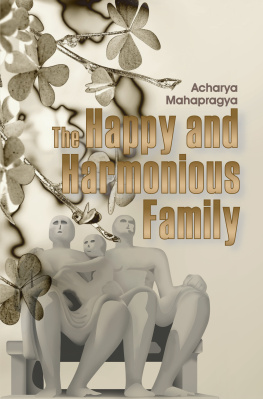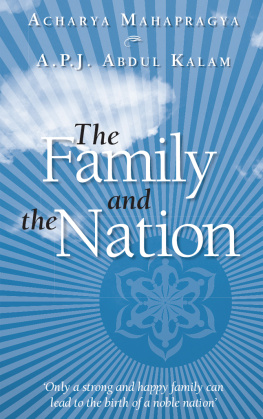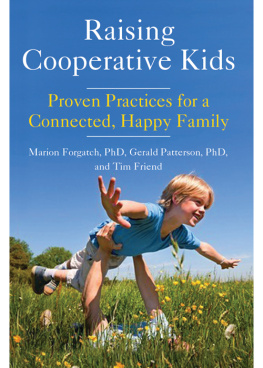
T HE H APPY AND H ARMONIOUS F AMILY
Acharya Mahapragya

T ABLE OF C ONTENTS
T here are two important values for leading a successful and satisfying family life. These are assurance and trust. Relationships cannot be sustained without these. In order to lead a blissful and peaceful life, we must nurture the seeds of trust within our families. The system of joint family has always been based on these values. Family life should be organized in such a manner that no member feels left out or isolated.
Tolerance is the protective armour for any joint family. Mutual understanding is the vital force behind it. Unfortunately, the power of tolerance and the feeling of mutual dependence are reducing day by day.
With development of the virtues of tolerance and peaceful co-existence, one can individually and collectively bloom in a joint family. We can imbibe these values by learning, practising and sharing them with our family and friends. That is why contemplation has been incorporated to develop the values of amity, compassion, tolerance, co-existence and reconciliation in this book.
This book is a humble effort at moving ones thoughts towards and strengthening ones conviction regarding the many benefits of a joint family.
Mukhya Niyojika Sadhvi Vishrut Vibha has translated the text into English. I hope that this book will encourage people to understand the true meaning of a happy family.
I am happy that HarperCollins has taken up this book for publication. I hope this will help the book reach out to a wider audience.
Jain Vishva Bharati, Ladnun
27 August 2009
Acharya Mahapragya
D r A.P.J. Abdul Kalam, a great scientist and former President of India, once said, If someone asks me what are my plans for the year 200708, I would say, last year was the year of knowledge enhancement, but for the next year, and all the coming years I would ask people to concentrate on the unity of the family. If the family is united, the establishment of a beautiful society, beautiful nation and beautiful world is possible.
In fact, the family is the foundation of a beautiful nation. It is not merely a group of people but an institution where one learns the lesson of living co-operatively.
The modern age is the age of economic competition. There is a question mark over the future of a healthy family. Today, relationships have become distant and families are dispersing within the country and across the world. Even while sharing the same premises, everybody is isolated within himself. The nature of conversations between parents and children is deteriorating. Each house seems to be burning with restlessness and belligerence. People living in metropolises are progressing swiftly, but the internal struggle within the family is ever increasing. It seems that prosperity and peace cannot live together.
The Happy and Harmonious Family will direct you how to live a happy and peaceful life within a family. Merely theory will not serve the purpose. It is necessary to practise the solutions mentioned in the book. This is why we have added some practices of contemplative meditation, so that everyone can actually implement them and make the atmosphere of the family healthy and peaceful.
The Hindi version of this book, Parivar Ke Saath Kaise Rahein, became very popular. It was edited by Muni Dhananjaykumarji. In Udaipur, in 2007, he requested Acharya Shree to have it translated in English. I asked Acharya Shree, If you allow me, I shall try my best to work on this translation. Acharya Shree agreed. Though it was an arduous task, I still made a tremendous effort and completed the translation within four months. Lalita Dhariwal and Praneta Rajeshbhai Mehta edited the text. The final touches were given by Samni Charitra Pragyaji, who is a visiting professor at Florida International University, Miami (USA). Sanjeev and Shivani Bothra did the layout and design of the books first edition. I am grateful to all of them.
Finally, I am indebted to Acharya Shree Mahapragya, Yuvacharya Shree Mahashraman, and Sadhvi Pramukha Kanak Prabha who motivated me to accomplish this translation.
Jain Vishva Bharati, Ladnun
7 August 2008
Sadhvi Vishrut Vibha
1
H OW TO L IVE IN A F AMILY ?
The development of spiritual consciousness is the stepping stone for peaceful co-existence within any family or society.
M an is a social being. He lives in society. The smallest unit of society is the family. If an individual can live peacefully with a few people, he can possibly adjust with a larger group as well. However, if the atmosphere within a small group itself is quarrelsome, life becomes a hell for him. For a calm and quiet life, it is necessary for an individual to live with others in a family in a peaceful manner.
The main objective of peaceful co-existence in the world is that a nation deals non-violently with other nations and accepts peaceful co-existence for itself. However, it will be difficult to accept this broad view if a man is unable to maintain peace within his own family.
The desire for peace is an inherent part of human nature. It is what man desires the most. But somehow, man is not able to maintain such a state. He needs to be trained for leading a peaceful life. The first lesson of this training is Peaceful Co-Existence within a Family. This, though desired by all, is not achieved by many. Why? What are the reasons? Lets try elaborating them. We cannot proceed without understanding the root cause of the problem.
All human beings are gifted with three miraculous powers mind, body and speech. Through these a man interacts with the external world. However, the inner world of consciousness is beyond these. The cause of all our problems lies within our inner world. The cause of its agitation is an unbalanced consciousness. All our senses are directed by consciousness. Unless and until our consciousness is balanced, our sensesmind, body and speechremain disturbed, and our discerning power doesnt awaken to develop the knowledge that can lead us to the truth.
T HE TWO ASPECTS OF CONSCIOUSNESS
There are two forms of consciousness:
 Individual consciousness
Individual consciousness
 Collective (Communal) consciousness.
Collective (Communal) consciousness.
Individual consciousness is further divided into two parts:
 Spiritual consciousness
Spiritual consciousness
 Selfish consciousness.
Selfish consciousness.
T HE FIRST ASPECT OF INDIVIDUAL CONSCIOUSNESS SPIRITUAL CONSCIOUSNESS
I am alone. I was born alone. I experience joy and sorrow alone. My soul is alone and has no company.
Such thoughts are produced by individual consciousness. It is true that we cannot share anyones joy or sorrow. We can only sympathize with others but cannot actually experience the same emotion that the other individual might be experiencing. Suffering is personal and a reality related to individual consciousness. Joy, sorrow, birth and death are all related to the soul.
According to one perspective, individual consciousness can be described as spiritual consciousness. Acharya Kundakunda has given a beautiful description of individual consciousness: I am alone. I am free from passion and endowed with faith and knowledge. When engrossed in its real form, the soul achieves the state of elimination of inflowing karmas .
The description above highlights the concept of detachment from the external world. I am alone and a pure soul. I own nothing, no wealth, no asset, no family, no friends nor relatives. This seems to be an odd concept. An individual has a sense of belongingness for his friends, family and wealth. Society is formed on the basis of attachment. However, the gist of individual and spiritual consciousness begins where selfish feelings and attachment end.
Next page













 Individual consciousness
Individual consciousness